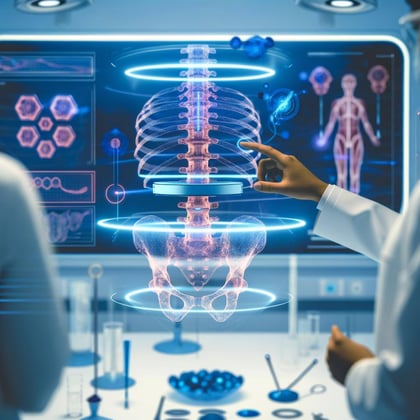Disc herniation, a common cause of spinal pain, occurs when the soft inner core of an intervertebral disc (nucleus pulposus) protrudes through a tear in the outer ring (annulus fibrosus).
This can lead to nerve compression, inflammation, and pain.
Treatment options for disc herniation range from conservative approaches to surgical interventions, with regenerative medicine emerging as a promising avenue.

Conservative Management
Conservative management is often the first line of treatment for disc herniation and aims to alleviate pain, reduce inflammation, and improve function. These approaches include:
- Physical Therapy: Physical therapy plays a crucial role in managing disc herniation. It focuses on strengthening core muscles, improving flexibility, and correcting postural imbalances. Exercises may include stretching, aerobic conditioning, and targeted strengthening of the back and abdominal muscles. Physical therapists may also employ modalities like heat, ice, ultrasound, and electrical stimulation to reduce pain and inflammation.
- Pharmacological Therapy: Medications are commonly used to manage pain and inflammation associated with disc herniation. Nonsteroidal anti-inflammatory drugs (NSAIDs) like ibuprofen or naproxen can help reduce pain and swelling. Muscle relaxants may be prescribed to alleviate muscle spasms. In some cases, oral steroids or epidural steroid injections may be considered for short-term pain relief.
- Lifestyle Modifications: Lifestyle changes can significantly impact the management of disc herniation. Maintaining a healthy weight reduces stress on the spine. Proper ergonomics at work and home can prevent further injury. Avoiding activities that exacerbate pain and incorporating low-impact exercises like walking or swimming can promote healing.

Interventional Techniques
If conservative measures fail to provide adequate relief, interventional techniques may be considered.
These minimally invasive procedures aim to address the underlying cause of pain and promote healing.
- Epidural Steroid Injections: Epidural steroid injections deliver corticosteroids directly into the epidural space surrounding the spinal cord and nerve roots. This can help reduce inflammation and alleviate pain caused by nerve compression.
- Facet Joint Injections: Facet joints are small joints in the spine that can become inflamed or arthritic due to disc herniation. Facet joint injections deliver corticosteroids and local anesthetics to reduce inflammation and pain in these joints.
- Nerve Root Blocks: Nerve root blocks involve injecting local anesthetics and/or steroids around specific nerve roots to alleviate pain caused by nerve irritation or compression.
- Radiofrequency Ablation: Radiofrequency ablation uses heat to disable nerves that transmit pain signals from the facet joints. This can provide longer-lasting pain relief than injections.
Regenerative Medicine
Regenerative medicine offers innovative approaches to promote tissue repair and regeneration in disc herniation.
These therapies aim to restore disc structure and function, potentially providing long-term pain relief and functional improvement.
- Platelet-Rich Plasma (PRP) Injections: PRP is a concentrated preparation of platelets derived from the patient's blood. It contains growth factors that promote tissue healing and regeneration. PRP injections into the damaged disc can stimulate cell proliferation, reduce inflammation, and potentially restore disc height.
- Mesenchymal Stem Cell (MSC) Injections: MSCs are multipotent stem cells that can differentiate into various cell types, including those found in the intervertebral disc. MSC injections into the disc can potentially regenerate damaged tissue, reduce inflammation, and improve disc function.
- Other Biologics: Other biologics like bone marrow aspirate concentrate (BMAC) and growth factor injections are also being investigated for their potential in disc regeneration.

Surgical Interventions
In cases where conservative and interventional treatments fail to provide relief, or if there are signs of neurological deficits, surgical intervention may be necessary. Surgical options include:
- Discectomy: Discectomy involves removing the herniated portion of the disc to relieve nerve compression. It can be performed through various approaches, including open surgery, microdiscectomy, or endoscopic discectomy.
- Spinal Fusion: Spinal fusion involves joining two or more vertebrae together to stabilize the spine and eliminate motion at the affected segment. It is typically performed in cases of severe disc degeneration or instability.
- Artificial Disc Replacement: Artificial disc replacement involves replacing the damaged disc with an artificial implant to maintain motion and flexibility in the spine.

Conclusion
The treatment of disc herniation is multifaceted, with various options available depending on the severity of symptoms, patient preferences, and response to initial therapies.
Conservative management, interventional techniques, regenerative medicine, and surgical interventions all play a role in managing this condition.
Regenerative medicine, in particular, holds great promise for the future, offering the potential for tissue regeneration and long-term pain relief.
As research in this field advances, we can expect to see more refined and effective regenerative therapies for disc herniation, improving the quality of life for countless individuals suffering from this debilitating condition.
We are a team of Orthopedic and Trauma specialists based in Bogotá, Colombia, certified by the International Society for Stem Cell Application (ISSCA) and dedicated to providing cutting-edge regenerative medicine treatments.
To learn more about how regenerative medicine could benefit you, please fill out our form and tell us about your specific needs.